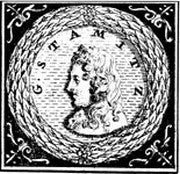Stamitz, Johann (1717 - 1757)
 |
Johann Wenzel Anton Stamitz, one the most influential figures in European music during the mid-Eighteenth Century, was born in Nemecky Brod (German: Deutschbrod) in June 1717. His father, Antonín Ignác, was organist at the Dean's Church and later became a merchant, landowner and town councillor. Johann probably received his early musical training from his father before entering the Jesuit Gymnasium in Jihlava in 1728. Stamitz is known to have been a student in the Faculty of Philosophy at the University of Prague during the academic year 1734-35 and is thought to have left the University in order to establish a career as a violin virtuoso. He was probably engaged as a violinist by the Mannheim Court in 1741-42 as a result of contacts made during the coronation in Prague, as King of Bohemia, of the Bavarian Elector Carl Albert, one of whose closest allies was the Elector Palatine. The earliest known reference to a concert appearance by Stamitz occurs in an advertisement for a concert in Frankfurt am Main on 29 June 1742 at which he was to perform alternately on the violin, viola d'amore, cello and double bass as well as furnishing a concerto for two orchestras of his own composition. Stamitz's professional career took off in Mannheim. In 1743 he was named "Erster Hoff Violinist" (First Court-Violinist); in 1745 or 1746 - the date is uncertain - he was awarded the title Concertmeister and in 1750, was named to the newly-created post of "Instrumental-Music Director". Under the Elector Carl Theodor (1724-99), an enlightened ruler with strong interests in philosophy, science and the arts, the court at Mannheim became one of the most glittering in Europe. Although an important patron of art and literature, Carl Theodor's central interest was music and he spared neither effort nor expense in building his court into one of the leading musical centres in Europe. In addition to presenting regular productions of new operas and ballets, the Mannheim Court engaged a number of exceptional musicians, among them Franz Xaver Richter, the flautist Johann Baptist Wendling, Ignaz Holzbauer and the cellists Innocenz Danzi and Anton Fils (Filtz), all of whom played in the incomparable orchestra led by Johann Stamitz. The Mannheim orchestra presented weekly 'academies' in the Rittersaal (the Knight's Hall) at the Electoral Palace. These academies were relatively informal social gatherings and visitors were often given standing room to hear the performance. The academies were the primary responsibility of the Concertmeister and Stamitz was required to prepare and conduct the performance, perform occasional concertos and provide orchestral compositions of his own. While the orchestra achieved its greatest fame in the two decades following Stamitz's death, there can be little doubt that he provided the original impetus toward the development of its new style of accurate, precise performance. In one of the most famous descriptions of the Mannheim court orchestra the aesthetician C.F.D. Schubart recalled that listening to the orchestra, "one believed oneself to be transported to a magic island of sound... No orchestra in the world ever equalled the Mannheimers' execution. Its forte is like thunder; its crescendo like a mighty waterfall; its diminuendo a gentle river disappearing into the distance; its piano is a breath of spring..." while Dr Charles Burney, the English music historian, observed: "indeed, there are more solo players, and good composers in this, than perhaps in any other orchestra in Europe; it is an army of generals, equally fit to plan a battle, as to fight it". In the late summer of 1754, Stamitz undertook a year-long journey to Paris, appearing there for the first time in a Concert Spirituel of 8 September 1754. While in Paris he lived at Passy in the palace of the fermier général Alexandre-Jean-Joseph-Le Riche de la pouplinière, a wealthy amateur whose private orchestra he conducted, and was also active in public concerts in the French capital, appearing with particular success at the Concerts Italiens. Stamitz probably returned to Mannheim in the autumn of 1755, dying there less than two years later aged 39. The official record of his death reads: "March 30, 1757. Buried, Jo'es Stainmiz, director of court music, so expert in his art that his equal will hardly be found. Rite provided". |


